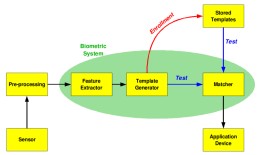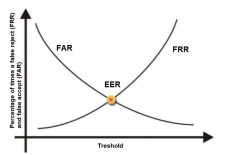Biometric principles
Although the various biometric technologies vary in what and how they scan, the principle of operation is very similar. A biometric system is a real-time identification system which identifies a person by measuring a particular physical or behavioral characteristic and later comparing it to a library of characteristics belonging to many people. Biometric devices consist of a reader or scanning device, software that converts the scanned information into digital form, and wherever the data is to be analyzed, a database that stores the biometric data for comparison with previous records. When converting the biometric input, the software identifies specific points of data as match points. The match points are processed using an algorithm into a value that can be compared with biometric data scanned when a user tries to gain access.
Verification vs. identification
Depending on the application context, a biometric system can operate either in verification or identification mode.
In verification mode the system performs a one-to-one comparison of a captured biometric with a specific template stored in a biometric database in order to verify the individual is the person they claim to be. 'Positive recognition' is a common use of verification mode, where the aim is to prevent multiple people from using same identity.
In identification mode the system performs a one-to-many comparison against a biometric database in attempt to establish the identity of an unknown individual. The system will succeed in identifying the individual if the comparison of the biometric sample to a template in the database falls within a previously set threshold. Identification mode can be used either for 'positive recognition' (so that the user does not have to provide any information about the template to be used) or for 'negative recognition' of the person where the system establishes whether the person is who she (implicitly or explicitly) denies to be.
Performance of biometric systems
There are many characteristics which make it possible to compare the biometric systems. The following are the most used as performance metrics for biometric systems:
-
False Rejection Rate (FRR): the probability that the system fails to detect a match between the input pattern and a matching template in the database. It measures the percent of valid inputs which are incorrectly rejected.
-
False Acceptance Rate (FAR): the probability that the system incorrectly matches the input pattern to a non-matching template in the database. It measures the percent of invalid inputs which are incorrectly accepted.
-
Equal Error Rate (EER): the rate at which both accept and reject errors are equal. The value indicates that the proportion of false acceptances is equal to the proportion of false rejections. The lower the equal error rate value, the higher the accuracy of the biometric system.
Identification and verification methods
To confirm the personal identity are used by different physiological characteristics and behavioral features. In practice there are constantly discovering new ways to measure the attributes and the uniqueness. Some of these systems are constantly under development and are not available in a form that could be used in identification systems.
Hand

Measuring the physical characteristics of hand and fingers from a three-dimensional perspective
False Rejection Rate (FRR): 0,1%
False Acceptance Rate (FAR): 0,1%
Verification time: 1 až 2 sekundy
Fingerprint
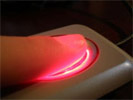
Optical, capacitive or thermal fingerprinting ("minutážne" body alebo tvar papilár)
False Rejection Rate (FRR): <1%
False Acceptance Rate (FAR): from 0,0001% to 0,00001% depending on type
Verification time: 0,2 - 1 sec.
Face

Facial recognition
False Rejection Rate (FRR): <1%
False Acceptance Rate (FAR): 0,1%
Verification time: 3 sec.
Eye
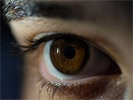
Iris scanning
False Rejection Rate (FRR): 0,00066%
False Acceptance Rate (FAR): 0,00078%
Verification time: 2 sekundy
Other methods:
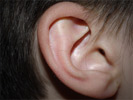
There are currently explored other methods of biometric identification and verification:
- retina: the analysis of the capillary vessels located at the back of the eye
- signature: the analysis of the way a person signs his name
- ear: the analysis of ear shell shape
- vein: the analysis of pattern of veins
- voice: the analysis of the tone, pitch, cadence and frequency of a person's voice
For more information register in Expert zone, call or send e-mail









